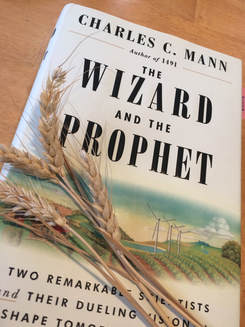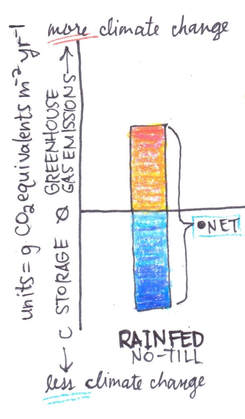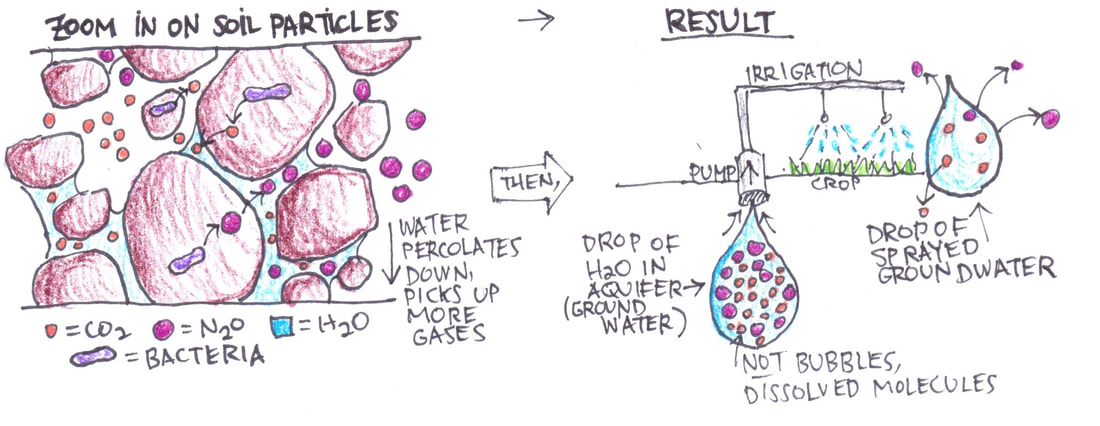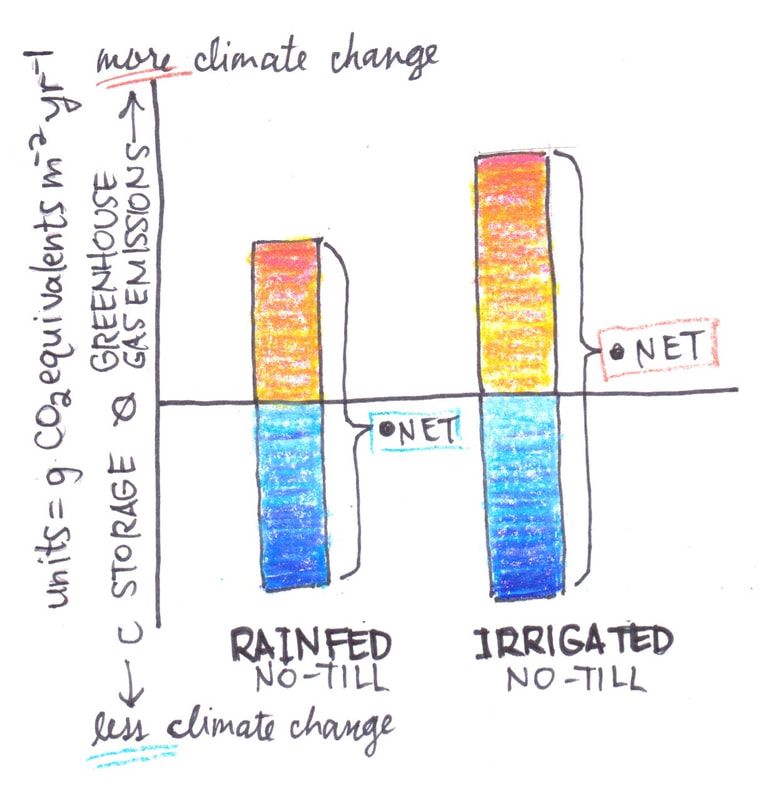|
This blog post is written to explain the results from my research at the KBS LTER to middle and high school students I’m working with through the Skype a Scientist program. Any scientist or teacher can sign up to participate. Update 25 Oct. 2018: You can now read the open access journal article on this work in Global Change Biology. Who are you and what do you do? I’m an ecosystem ecologist. An ecosystem is a living community and its non-living physical environment such as its rocks, water, and air. I study how the living and non-living parts of an ecosystem interact, which determines the ecosystem’s functions or services like cleaning water, producing food, and decomposing dead things. I am particularly interested in agricultural ecosystems like corn and soybean fields, how farmers manage that land, and what effects those choices have on ecosystem functions like adding to or preventing air and water pollution. Scientists at the KBS LTER have shown that we can produce just as much (or more) food using fewer man-made materials, which involve burning fossil fuels, and using more ecosystem services like nitrogen-fixing cover crops (Figure 1). Relying more on ecosystem services reduces farm costs, such as buying insecticides, and reduces the amount of pollution from farms to the air and water. Ecosystem services can also make the farm more resilient to climate variability. Some of that air pollution can be in the form of greenhouse gases like carbon dioxide (CO2), nitrous oxide (N2O), and methane (CH4), which retain more heat in the atmosphere, warming the earth. Did you know that greenhouse gas emissions from agriculture make up about 10% of the total man-made emissions in the US? Figure 1. Farming with fossil fuels (left) or ecosystem services (right).(1) Tilling the soil breaks down soil structure making it more vulnerable to erosion by wind and water (4, left). Not tilling the soil (no-till) builds up soil structure, protects the soil from erosion, and allows the soil to store more organic material (carbon) and water (4, right). To kill weeds no-till requires synthetic herbicides, which are made, transported, and applied using fossil fuels (2, left). Conventional farming uses insecticides to control crop pests, while farming with ecosystem services promotes biodiversity in the landscape such that natural predators of crop pests (ladybugs, birds, etc.) control crop pests. This means leaving a patch of forest rather than turning it into a crop field and/or planting patches of wildflowers at the edges of fields. (3, left) Man-made nitrogen fertilizer requires a lot of fossil fuels to produce, while a nitrogen-fixing cover crop (3, right) can provide nitrogen to the soil without as much fossil fuels. At the KBS LTER, I wanted to measure the carbon footprint of irrigation—spraying water on crops. By carbon footprint, I mean how irrigation impacts a farm’s contribution to or prevention of climate change. In other words, does an irrigated corn field contribute more or less greenhouse gases to the atmosphere than a rainfed (non-irrigated) field? What did you find?
You see, as water percolates through the soil and through the aquifer (Figure 3, left), microbial processes like respiration and denitrification are occurring, but their gas products can’t escape. Instead gases like CO2and N2O build up to really high concentrations in the water in dissolved form. Then, when that water is exposed to the atmosphere (Figure 3, right) the gases equilibrate with the atmospheric concentration of those gases, much like when you open a new bottle of pop—CHHHH! The CO2 escapes from the pop. So groundwater-irrigated farming has this additional source of greenhouse gases on top of regular greenhouse gas emissions from rainfed farming. This surprised me because other studies like this one did not measure this source. Figure 3. We discovered greenhouse gas emissions from groundwater-fed irrigation. Previous studies of the carbon footprint of irrigation did not measure the greenhouse gas content of the irrigation water itself. We measured the concentration of CO2, N2O, and CH4 in groundwater before it was sprayed on the field (lower water drop) and calculated how much gas was lost when the water equilibrated with the atmosphere (upper water drop). Also, irrigation requires more fossil fuels than rainfed crops in order to pump the water from belowground. At the KBS LTER, about 75% of our electricity comes from fossil fuels (60% of the total comes from coal). (Where does your electricity come from?) Besides these additional sources, irrigation also increased the amount of N2O emissions from the soil (also found in rainfed soils but at lower rates) by encouraging denitrification, a process carried out by soil bacteria.
CO2-equivalents per kg crop yield (AKA greenhouse gas intensity), both the rainfed and irrigated systems are very close to zero net impacts at KBS. So rainfed doesn't look quite as rosy and irrigation doesn't look as bad. The downside is that intensification with irrigation puts more demand on aquifers and rivers to provide the irrigation water. The majority of the world's aquifers supporting the most important agricultural areas are already overexploited.
These results are specific to KBS, and could very well differ by climate, tillage (we did not compare tilled vs. no-tilled), and soil type. We don’t have many studies like this, in fact this is the first one for the US Midwest. Why is your work exciting? Irrigation, thought of as a way for farmers to adapt to climate change, might actually be contributing to climate change. All the more reason for improving irrigation efficiency to minimize impacts on water resources and reduce contributions to climate change. In the big picture, this work excites me because it has implications for real world issues. I like being a part of the LTER community of scientists trying to figure out how human activities contribute to climate change, how we can modify those activities to reduce or reverse their contribution to climate change, and what is the best way to work with farmers to help them meet their yield goals and (not or) conservation goals.  The Wizard and the Prophet by Charles C. Mann (2018) provides contrasting biographies of two influential 20th century scientists: Norman Borlaug (the “wizard”) and William Vogt (the “prophet”). Each man had a different approach to different facets of the same problem: human population growth, consumption, and resource extraction. Each had their own brush with the real world as young adults, which shaped their different life goals. Borlaug grew up on a small, subsistence farm in northeast Iowa that had poor soil. When his family finally got a Fordson Model F tractor they were able to send Norman to high school. In Borlaug’s own words, the tractor provided “relief from endless drudgery equated to emancipation from servitude”. In college at the U. of Minnesota in Minneapolis in 1933, Borlaug came face to face with the horrors of the Great Depression—hungry, cold, homeless people, many of whom were dairy farmers whose land and animals had been sold to pay their debts when the price of milk dropped. Violence erupted across the Midwest as these dairy farmers and their families blocked milk trucks in their milk strikes, including a strike in Minneapolis that Borlaug witnessed, which proved to be a formative moment in his life. He went on to try to free subsistence farmers around the world from the threat of hunger by providing farmers with technology (plant breeding) and resources (synthetic fertilizer). He, along with an Indian scientist named M. S. Swaminathan, set out to help people like the starving Midwestern dairy farmers left behind by the US government and the starving Indians in Bengal whom Winston Churchill refused to help in 1943. Borlaug’s graduate research dealt with rust fungus that infects wheat fields. After graduation he got a job in Mexico, where he conducted a superhuman feat of wheat breeding: high volume crossbreeding among a global collection of wheat varieties and shuttle breeding between two alternating climates in Mexico (Chapingo, southwest of Mexico City, and the infamous Yaqui Valley, on the Gulf of California). After long days, lots of hard work, some plowing by hand, frustrating his bosses, and a little luck, he managed to develop a variety that revolutionized the world. Several qualities made this wheat special: it would germinate no matter how long the day length was (i.e., it could germinate anywhere), it was highly resistant to disease (a big problem up to then), it was a dwarf (i.e., it didn’t lodge in the wind or rain) that retained the large seed head of taller wheat, and (of course) the grain stayed on the head “waiting” for humans to harvest it. That’s quite a laundry list of breeding accomplishments for 1960—recall Watson and Crick published their seminal paper on the structure of DNA in 1953. Wheat yields tripled in Mexico, India and Pakistan, but these yields required expensive seeds, synthetic fertilizer inputs, and more water, opening the floodgates to modern day industrial agribusiness and its associated environmental harms. Borlaug helped small landholder farmers produce more food, but also enabled population growth, which required even more food, and the cycle continues. This is why many people don’t like Borlaug, the “father of the Green Revolution” who directly and indirectly set in motion a cascade of environmental degradation. But his intention was to help the farmers, which he did using cutting-edge (at the time) science, and was awarded the 1970 Nobel Peace Prize. Hence, Mann designated Borlaug the wizard—he engineered a solution to the problem. William Vogt’s life was also interesting—a child naturalist on Long Island before the Hamptons, and an American spy in Latin America during WWII. He worked for the Audobon Society, where he befriended Aldo Leopold. Mann deems Vogt a prophet because his life’s work was about restraint from resource use and reducing population growth. His formative brush with real life came during his Ph.D. when he witnessed the population crash of Guanay cormorants on a profitable guano island in Peru—the guano was exported as fertilizer before synthetic fertilizer came into use. Vogt figured out the crash was tied to El Nino, and that the Peruvian guano company could not “augment the increment of excrement”. They could only remove additional challenges to the birds created by human impacts, enabling the birds to live within ecological limits. Vogt later wrote Road to Survival, which included indirect criticism of Borlaug’s work, is considered the beginnings of the modern environmental movement, and inspired Paul Ehrlich and Rachel Carson. Vogt’s inspirational experience with the cormorants, led him to focus on how human activity led to the suffering of animals and their environment, compared to Borlaug who focused on how poverty and the limitations of the environment brings human suffering. Borlaug’s impact on population growth and Vogt’s cry for population control, were not popular with many people. Both men struggled with, in Mann’s words, “the clash between the workshop and the world.” Often scientist’s bench top solutions don’t work so well in the real world because the bench top is, obviously, not the real world: different cultures have unique preferences for the look and taste of wheat; bureaucracy and greed prevent the seeds, fertilizer and wells from reaching the poorest farmers; unforeseen consequences emerge, such as population growth. Vogt was also seen as a disconnected scientist with condescending criticism about human reproduction. Both men could have benefited from a socio-ecological approach and some tips on science communication. This sounds like light-hearted criticism but really the stakes are quite high. Mann cites philosopher Edmund Husserl who in the 1930s wrote about how distrust in scientists and experts contributed to society following the irrational and the rise of Nazism. Socio-ecology and science communication sound pretty important today too, eh? You can read an excerpt from the book in The Atlantic. |
Archives
February 2019
Categories |




 RSS Feed
RSS Feed
